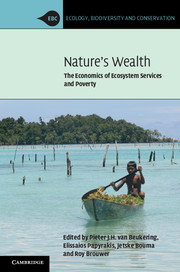Book contents
- Frontmatter
- Contents
- List of contributors
- Acknowledgements
- 1 The economics of ecosystem services and poverty
- Part I Biodiversity-related ecosystem services
- 2 Park–people conflicts, rhino conservation and poverty alleviation in Nepal
- 3 Rural poverty and human–elephant conflicts in Sri Lanka
- 4 Poverty, livelihoods and the conservation of nature in biodiversity hotspots around the world
- Part II Marine-related ecosystem services
- Part III Forest-related ecosystem services
- Part IV Water-related ecosystem services
- Part V Land-related ecosystem services
- Index
- References
4 - Poverty, livelihoods and the conservation of nature in biodiversity hotspots around the world
Published online by Cambridge University Press: 05 July 2013
- Frontmatter
- Contents
- List of contributors
- Acknowledgements
- 1 The economics of ecosystem services and poverty
- Part I Biodiversity-related ecosystem services
- 2 Park–people conflicts, rhino conservation and poverty alleviation in Nepal
- 3 Rural poverty and human–elephant conflicts in Sri Lanka
- 4 Poverty, livelihoods and the conservation of nature in biodiversity hotspots around the world
- Part II Marine-related ecosystem services
- Part III Forest-related ecosystem services
- Part IV Water-related ecosystem services
- Part V Land-related ecosystem services
- Index
- References
Summary
Introduction
Globally, biodiversity is being depleted at an alarming rate (UN 2010). This is a problem, not only because biodiversity is intrinsically valuable, but also because it provides the basis for many ecosystem services that are crucial for human well-being. Biodiversity is best conserved in protected areas (Bruner et al. 2001) but the establishment of protected areas often has negative livelihood effects (Cernea and Schmidt-Soltau 2006). Particularly, since biodiversity is highest in the poorest parts of the world (Fisher and Cristoph 2007), there is an ongoing debate about how to protect biodiversity while improving local livelihoods and alleviating poverty at the same time. Recently, literature has started emerging that suggests that linking conservation outcomes directly to local livelihood improvement is the best way of protecting biodiversity and alleviating poverty at the same time (Ferraro and Kiss 2002, Niesten and Milne 2009). In this chapter we assess local dependence on the surrounding ecosystem, but focus the analysis on the potential for community co-management of protected areas as a means of improving conservation and avoiding negative livelihood effects.
The study analyses the potential synergies for nature conservation and local livelihood improvement in four biodiversity hotspots around the world (India, South Africa, Vietnam, Costa Rica). This makes it possible to compare approaches and assess the interdependencies between nature conservation and local livelihoods. In all four regions biodiversity is conserved in protected areas, but the type of management, the type of ecosystem pressures and the type of livelihood strategies differ between the sites. The main aim of the analysis is get an understanding of whether synergies between nature conservation and local livelihoods are indeed possible, with a specific focus on the potential for community co-management in the different sites.
- Type
- Chapter
- Information
- Nature's WealthThe Economics of Ecosystem Services and Poverty, pp. 74 - 106Publisher: Cambridge University PressPrint publication year: 2013
References
- 2
- Cited by



